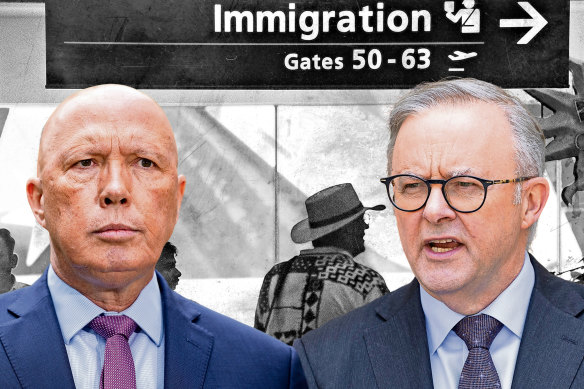This was published 11 months ago
Opinion
Dutton’s dog whistle will sound if Albanese fails this migration test
Abul Rizvi
Former deputy secretary of the Department of ImmigrationThe Albanese government’s new migration strategy is a step in the right direction. But a failure to deliver on its promises – particularly regarding cuts in net migration numbers – will be ruthlessly punished by its political opponents.
When international borders reopened in early 2022, the Coalition government had in place, or introduced, extraordinary measures to increase arrivals of students and working holidaymakers, two of the major drivers of Australia’s current surge in net migration. These measures included fee-free visa applications, unlimited student work rights and the special COVID visa for any temporary entrant in Australia who could secure any job. These measures rapidly accelerated visa applications.

Opposition leader Peter Dutton looks set to make immigration a key election issue, especially if Prime Minister Anthony Albanese fails to get migrant numbers under control.Credit:
Later in 2022, following a federal election and change of government, businesses were complaining about labour shortages and major lobby groups were hammering the Albanese government to increase immigration. Opposition Leader Peter Dutton quickly blamed the government for not being responsive to business concerns during a very hot labour market.
The government increased the permanent migration program – that is, the number of permanent visas issued irrespective of whether the person is in Australia or not – and began clearing the massive backlog of applications it had inherited from the Coalition. But by the end of that same year, it was clear net migration was booming and on track to reach record levels.
Historically, once net migration in Australia has approached around 300,000, complaints inevitably point to immigration for almost every problem people have, irrespective of whether the link is true or not. That includes things like a lack of infrastructure, urban congestion, housing shortages, government service delivery being overwhelmed, and the cost of living.
Despite the noise, the government, surprisingly, did not tighten immigration policy until well into this year. Initially, most of the measures it took were insufficient to adequately dampen net migration, and the opposition switched tactics, blaming the government for letting numbers blow out.
The good news is this has led to the government, for the first time in Australia’s history, announcing a migration strategy focussed on net migration – that is, the net long-term and permanent movement of people into and out of Australia. For over a decade, as long-term temporary migration has increased significantly, we have needed governments to focus on managing net migration, not just the permanent migration program. The new migration strategy appears to do just that. Although disappointingly, Home Affairs Minister Clare O’Neil insists the proposed reductions in net migration are “estimates”, not “targets”.
This is a continuation of Treasurer Jim Chalmers’ insistence earlier this year that Treasury’s net migration forecasts are neither targets nor a policy.
If the Albanese government thinks not delivering net migration numbers in its strategy is an option, it will face an ugly immigration-focused election in 2025, with Dutton almost certainly using his exceptional dog-whistling skills to full effect. It will be “African gangs” on steroids.
Managing net migration is hard because there are many aspects of it that a government does not control, including the movement of Australian citizens. But government has sufficient control of many aspects, including the ability to ensure outcomes are within a reasonable range of the target, say plus or minus 10,000. Letting net migration blow out by 200,000 or more outside the “estimate” will be unacceptable.
The Albanese government desperately needs to put in place a rigorous framework for managing net migration and explaining that to the Australian public. We need assurances that the government is managing immigration in the national interest. Given bipartisanship on immigration is essential for social cohesion, hopefully, the opposition would support such a framework.
Most of the measures in the new strategy are sensible. It focuses almost entirely on further tightening existing policies on student and temporary graduate visas, which is understandable given students contributed almost 60 per cent to net migration in 2022. The real question is whether they will be effective and sufficient.
The key is to reduce the extraordinary rate of offshore student visa applications using objective criteria that target high-performing students and aim to select students who will do well in their studies, secure well-paying jobs and go on to become Australian citizens if they wish. Fee revenue for universities should be a secondary objective only.
If the offshore student visa application rate does not decline and the government relies mainly on high refusal rates using subjective criteria and slow visa processing, net migration will not fall nearly as quickly as the government wants it to. That approach is enormously resource intensive and will only make everyone involved angry.
A possible objective tool that could be used is university or college entrance exam results that are used across most of our source countries. There is no reason why it should be easier for an overseas student to get into a university or vocational college in Australia than it is to get into a top university or vocational college in their home country. Another advantage of using national entrance exam results is that the Australian government can dial exam result requirements up or down as needed to allow greater control over net migration.
However, the government needs to act quickly. It has already lost too much time letting net migration blow out.
Abul Rizvi is a former deputy secretary of the Department of Immigration and worked within the department from the early 1990s to 2007.